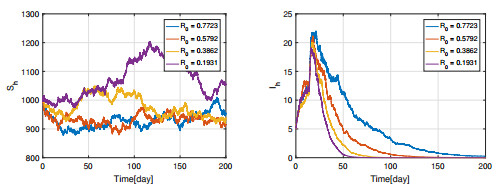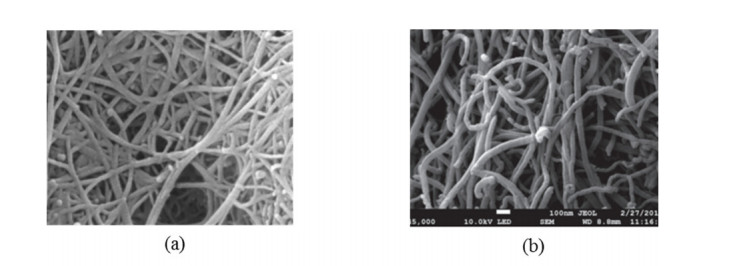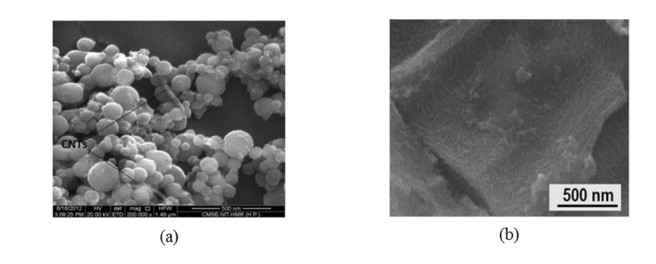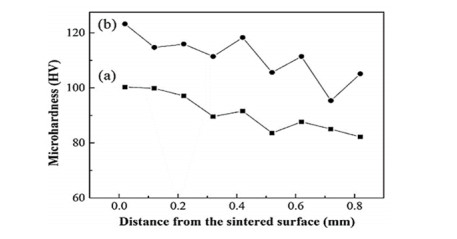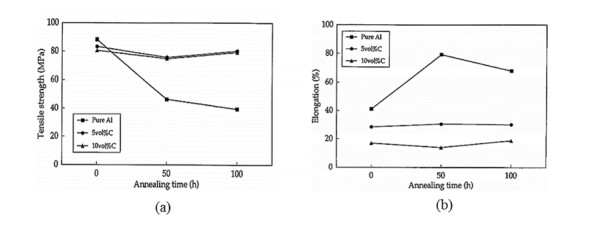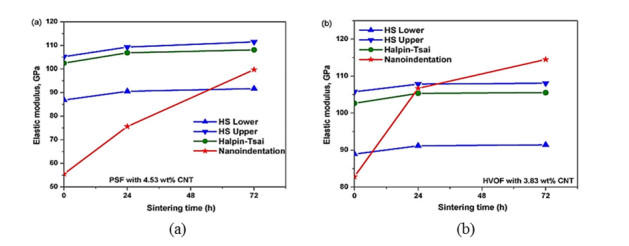Lightweight materials characterized by low density, high strength to weight ratio, low porosity, high corrosion resistance with improved mechanical, thermal, electrical properties are now extensively used in many engineering applications ranging from the deep sea to aerospace. Besides, the materials must be multifunctional comprises a fast and economic manufacturing technique. Metallic matrix CNTs composites such as Mg/CNTs and Al/CNTs have such the aforementioned quality. However, Mg/CNTs and Al/CNTs has some specific advantages and disadvantages that restrict their applicability. To harvest the dual benefit of Mg/CNTs and Al/CNTs, bimetallic matrix Mg-Al/CNTs may be prospected. Mg-Al bimetallic combination for alloying has substantial mechanical properties with heavy amalgamation. Therefore, interdisciplinary research on reinforcement, compacting, bonding, dispersion of CNTs in the bimetallic matrix, microstructure and defect analysis will open the door for producing new class of composite materials. In this work, various Mg/CNTs, Al/CNTs, Mg-Al composites have been studied to find the prospect of Mg-Al/CNTs composites. The worthwhile accomplishment of the reviews will provide the knowledge of fabrication for CNTs reinforced bimetallic Mg-Al based lightweight composites and understand its mechanical behaviors.
1.
Introduction
Avian influenza is an animal infectious disease caused by the transmission of influenza A viruses. Influenza A viruses are divided into subtypes according to two proteins on the surface of the virus: Hemagglutinin (HA) and neuraminidase (NA) [1]. Most avian influenza viruses infect only certain species and do not infect humans. However, a few avian influenza viruses have crossed the species barrier to infect humans and even kill them, such as H5N1, H7N1, H7N2, H7N3, H7N7, H9N2 and H7N9. Among them, H5N1 is a highly pathogenic avian influenza virus, which was first detected in human in Hong Kong in 1997. After that, humans infection with avian influenza have occurred from time to time. As of December 2019, the global cumulative number of cases of human infection with H5N1 avian influenza arrives 861, with 455 deaths. Unlike H5N1, H7N9 is classified as a low pathogenicity avian influenza virus [2]. In March 2013, there was the first case of human infection with the H7N9 avian influenza virus in Shanghai, China. In the following weeks, this virus spread to several provinces and municipalities in mainland China. As of May 2017, H7N9 has resulted in 1263 human cases in China, of whom 459 died, with a mortality rate of nearly 37%. The frequent outbreak of avian influenza in the world not only brings a serious threat to human health, but also causes psychological panic and huge social impact, and brings a huge blow to the national economy. Therefore, it has been important to understand the dynamical behavior of avian influenza and to predict what may occur. Mathematical modeling has been a useful tool to describe the dynamical behavior of avian influenza and to obtain a better understanding of transmission mechanisms. Recently, many avian influenza models have been built from different perspectives (see [2,3,4,5,6,7,8,9,10,11,12] and references therein).
As we all know, there exist time delays during the spread of avian influenza, which can be used to describe not only the infection period of avian influenza virus in poultry (human) population, but also the incubation period of avian influenza in poultry (human) population and the immune period of recovered human to avian influenza. Therefore, the time delays should be considered such that the avian influenza models are more realistic. Generally speaking, delayed differential equations exhibit more complex dynamical behavior than differential equations without delay because time delay can make a stable equilibrium position to be unstable [13,14,15,16]. Consequently, it is of great interest to describe the transmission mechanism of avian influenza by introducing time delay into the models. For example, Liu et al. [7] and Kang et al. [12] established avian influenza models with different time delays in the poultry and human populations by considering the incubation periods of avian influenza virus and the survival probabilities of infected poultry and humans. By considering the existence of intracellular delay between initial infection of a cell and the release of new virus particles, Samanta [17] established a non-autonomous ordinary differential equation with distributed delay to characterize the spread of avian influenza between poultry and humans. These surveys imply that the research of time delay on avian influenza is a meaningful issue and is still open for study.
On the other hand, many existing literatures only focus on the deterministic avian influenza models that do not consider the impact of environmental noise. However, in the real world, the spread of avian influenza is often affected by the variations of environmental factors, such as humidity, temperature and so on [18,19]. Due to the fluctuations in the environment, an actual avian influenza system would not remain in a stable state, which would interfere with this stable state by acting directly on the density or indirectly affecting the parameter values. Therefore, it is of great significance to reveal the impact of environmental noise on avian influenza model by using stochastic model, so as to obtain more real benefits and accurately predict the future dynamics of avian influenza. To better understand the transmission dynamics of avian influenza, some authors have introduced stochastic perturbations into the deterministic models [20,21,22]. Zhang et al. [20] constructed a stochastic avian-human influenza model with logistic growth for avian population, and discussed the dynamical behavior of this model. Further, Zhang et al. [21] investigated a stochastic avian-human influenza epidemic model with psychological effect in human population and saturation effect within avian population. On the basis of the deterministic model established by Iwami et al. [3], Zhang et al. [22] established the corresponding stochastic model by introducing density disturbance. All the papers mentioned above only focused on the extinction and persistence of stochastic avian influenza models. However, to the best of our knowledge, there is no results related to the asymptotic behavior of stochastic avian influenza model around the equilibria of the corresponding deterministic model.
Motivated by the above discussions, in this paper, we investigate the asymptotic behavior of a stochastic delayed avian influenza model with saturated incidence rate. This work differs from existing results [7,12,17,20,21,22] in that (a) time delays and white noise are taken into account to describe the latency period of avian influenza virus in both poultry and human population and the environmental fluctuations; (b) asymptotic behavior of a stochastic delayed avian influenza model is studied. Overview of the rest of the article is as follows: In section 3, we show that there exists a unique global positive solution of system (2.3) with the given initial value (2.4). In section 4, we prove that the solution of system (2.3) is going around E0 under certain conditions. Further, we derive that the solution of system (2.3) is going around E∗ under certain conditions in section 5. In section 6, some numerical examples are introduced to illustrate the effectiveness of theoretic results. Finally, some conclusions are given in section 7.
2.
Model description and formulation
Although the avian influenza virus spreads between wild birds and poultry, and between poultry and humans, we will only consider the transmission dynamics of avian influenza between poultry and humans because poultry is the main source of infection. Moreover, we assume that the virus is not spread between humans and mutate. We denote the total population of poultry and humans at time t by Na(t) and Nh(t), respectively. When the susceptible poultry contact with the infected poultry closely, there is usually no quick way to detect whether they are infected or the detection cost is too high, which makes it impossible to distinguish whether the close contacts of poultry are infected with the avian influenza virus. Therefore, the poultry population is divided into three sub-populations depending on the state of the disease: susceptible poultry Sa(t), exposed poultry Ea(t) and infected poultry Ia(t). The total poultry population at time t is denoted by Na(t)=Sa(t)+Ea(t)+Ia(t). The human population is divided into three sub-populations, which are susceptible human Sh(t), infected human with avian influenza Ia(t) and recovered human from avian influenza Rh(t). The total population of human at time t is given by Nh(t)=Sh(t)+Ih(t)+Rh(t).
The reason why we do not consider the exposed class for human population is that the close contacts of human beings are usually isolated and tested to determine whether they are infected with the avian influenza virus. The poultry in Ea either shows symptoms after incubation period and move to Ia, or always stays in Ea until natural death. The number of susceptible poultry (human) is increased by new recruitment, but decreases by natural death and infection (moving to class Ia (Ih)). The number of infected poultry (human) is increased by the infection of susceptible poultry (human) and reduced through natural and disease-related death. In addition, the number of infected humans is also reduced by recovery from the disease (moving to class Rh). Based on the above discussions, we obtain the schematic diagram of our model (see Figure 1).
The corresponding avian influenza model can be represented by the following equations:
All parameters in model (2.1) are assumed non-negative and described in Table 1.
Because the removed human populations Rh(t) has no effect on the dynamics of the first five equations, system (2.1) can be decoupled to the following system:
A realistic avian influenza system would not remain in this stable state due to environmental fluctuations. In this paper, we will reveal how the environmental white noise affects the spread of avian influenza through investigating the dynamics of a stochastic delayed avian influenza model with saturated incidence rate. Taking the same approach as the literatures [23,24], we assume that the environmental white noise is directly proportional to the variables Sa(t), Ea(t), Ia(t), Sh(t) and Ih(t), respectively. Then, corresponding to system (2.2), the stochastic avian influenza model with time delay is of the following form
in which Bi(t)(i=1,2,⋯,5) are mutually independent standard Brownian motions defined on a complete probability space (Ω,F,P) with a filtration{Ft}t≥0 satisfying the usual conditions (i.e., it is increasing and right continuous while F0 contains all P-null sets), σi(i=1,2,⋯,5) denote the intensities of the white noises. The initial value of system (2.3) are
where C is the Banach space C([−τ,0];R5+) of continuous functions mapping the interval [−τ,0] into R5+, and R5+={x=(x1,x2,x3,x4,x5):xi>0,i=1,2,3,4,5}. By a biological meaning, we assume that φi(0)>0(i=1,2,3,4,5).
3.
Existence and uniqueness of the global positive solution
In this section, we prove that the solution of system (2.3) is global and positive for any initial value (2.4).
Theorem 1. For any initial value (2.4), system (2.3) has a unique positive solution (Sa(t),Ea(t),Ia(t),Sh(t),Ih(t)) on t≥0 and the solution will remain in R5+ with probability one, in other words, (Sa(t),Ea(t),Ia(t),Sh(t),Ih(t))∈R5+ for all t≥0 almost surely.
Proof. Since the coefficients of system (2.3) satisfy the local Lipschitz conditions, then for any initial value (2.4), there exists a unique local solution (Sa(t),Ea(t),Ia(t),Sh(t),Ih(t)) on t∈[−τ,τe), where τe is the explosive time. To show this solution is global, we only need to show that τe=∞ a.s. To this end, let k0≥1 be sufficiently large such that (Sa(θ),Ea(θ),Ia(θ),Sh(θ),Ih(θ))(θ∈[−τ,0]) all lie within the interval [1k0,k0]. For each integer k≥k0, define the stopping time as
We set inf∅=∞. Obviously, τk increasing when k→∞. Let τ∞=limk→∞τk, where τ∞≤τe a.s. If we can verify τ∞=∞ a.s., then τe=∞ and (Sa(t),Ea(t),Ia(t),Sh(t),Ih(t))∈R5+ a.s. for all t≥0. That is to say, to complete the proof we only need to show that τ∞=∞ a.s. If this assertion is not true, then there is a pair of constants T>0 and ε∈(0,1) such that
There exists an integer k1≥k0 such that
Define a C2-function V: R5+→R+ by
in which a and b are positive constants to be determined later. The nonnegativity of this function can be derived from x−1−lnx≥0 for any x>0. Applying the Itô's formula to V, we get
where
Choose a=μaeμaτaβa and b=δaeμhτhβh or a=δaeμaτaβa and b=μaeμhτhβh such that
Then, we can get
where K is a positive constant. It thus follows from (3.2) that
Integrating both sides of (3.3) from 0 to τk∧T=min{τk,T} and then taking the expectation results in
Set Ωk={τk≤T} for k≥k1, and according to (3.1), we have P(Ωk)≥ε. For every ω∈Ωk, there exists Sa(τk,ω) or Ea(τk,ω) or Ia(τk,ω) or Sh(τk,ω) or Ih(τk,ω) equals either k or 1k. Therefore, V(Sa(τk,ω),Ea(τk,ω),Ia(τk,ω),Sh(τk,ω),Ih(τk,ω)) is no less either k−1−lnk or 1k−1−ln1k or k−a−alnka or 1k−a+alnak or k−b−blnkb or 1k−b+blnbk.
Therefore, we have
It follows from (3.4) that
where 1Ωk denotes the indicator function of Ωk. Letting k→∞, then
which leads to the contradiction. This completes the proof.
4.
Asymptotic behavior of system (2.3) around the disease-free equilibrium E0
In this section, we will investigate the solution of system (2.3) around disease-free equilibrium E0 under certain conditions. It is worthwhile to mention that, if R0=βaγaΛae−μaτaμa(μa+δa)(μa+γa)<1, the deterministic system (2.2) is globally asymptotically stable around the unique disease-free equilibrium E0=(S0a,0,0,S0h,0)=(Λaμa,0,0,Λhμh,0), but E0 is not the equilibrium of the stochastic system (2.3). Thus, the result concerning the solution of stochastic system (2.3) around E0 is presented by the following theorem.
Theorem 2. Let (Sa(t),Ea(t),Ia(t),Sh(t),Ih(t)) be the solution of system (2.3) with the initial value (2.4). If R0<1 and the following conditions hold
then,
where
Proof. Since (S0a,0,0,S0h,0) is the disease-free equilibrium of system (2.2), then
According to system (2.3), we can obtain that
and
Let V1=12(Sa−Λaμa)2, then applying the Itô's formula to V1, together with (4.1), we have
where
Similarly, let V2=Ea(t+τa)+μa+γaγaIa(t+τa)+(μa+γa)(μa+δa)γa∫t+τatIa(s)ds, it follows from (4.2) that
Define ˉV=e−μaτaV1+ΛaμaV2, then
Integrating both sides of (4.4) from 0 to t and taking expectation, we get
Therefore, we can obtain
Similarly, we define
then,
Let V4=V3+12(μa+γa−σ22)∫t+τatE2a(s)ds, we get
Let V5=12I2a, the derivative of V5 can be calculated as
The Young's inequality is used above. Let
which implies that
Integrating both sides of (4.5) from 0 to t and then taking expectation yields
Consequently, we can obtain
where M1 and P1 are defined in Theorem 2. Further, according to system (2.3), we have
and
Let V6=12(Sh−Λhμh)2. Noting (4.6), we have
Let V7=e−μhτhV6+ΛhμhIh(t+τh), it follows from (4.7) that
Integrating both sides of (4.8) from 0 to t and then taking the expectation yields
therefore, we can get
Let V8=12[e−μhτh(Sh−Λhμh)+Ih(t+τh)]2, then
Defining
we get
Integrating both sides of (4.9) from 0 to t and taking expectation, we obtain
Consequently, we can obtain
where P2 is defined in Theorem 2. This completes the proof.
5.
Asymptotic behavior of system (2.3) around the endemic equilibrium E∗
If R0>1, there exists an endemic equilibrium E∗=(S∗a,E∗a,I∗a,S∗h,I∗h) of system (2.2), but it is not the equilibrium of system (2.3), where S∗a=Λa(1+α1I∗a)μa(1+α1I∗a)+βaI∗a, E∗a=βaΛae−μaτaI∗a(μa+γa)[μa(1+α1I∗a)+βaI∗a], I∗a=μa(R0−1)α1μa+βa, S∗h=Λh(1+α2I∗a)μh(1+α2I∗a)+βhI∗a, E∗a=βhe−μhτhS∗hI∗a(μh+δh+θh)(1+α2I∗a). In this section, we show that the solution of system (2.3) is going around E∗ under certain conditions.
Theorem 3. Let (Sa(t),Ea(t),Ia(t),Sh(t),Ih(t)) be the solution of system (2.3) with initial value (2.4). If R0>1 and the following conditions hold
(i) σ21<μa,σ22<12(μa+γa),σ23<12(μa+δa),σ24<μh,σ25<μh+δh+θh;
(ii) max(√P3,√P4,√P5,√P6)<d(E∗,E0),
then
where
Proof. Since (S∗a,E∗a,I∗a,S∗h,I∗h) is the interior equilibrium of system (2.2), then
Define the Lyapunov function W1 as W1=Sa−S∗a−S∗alnSaS∗a, from which we have
where
Similarly, we can define W2 as
By using the Itô's formula, the derivative of W2 is calculated as follows
Since x−1−lnx≥0 for x>0, the following estimate can be obtained
Substituting (5.4) into (5.3), we can get
Choose W3=W2+βae−μaτaS∗aI∗a1+α1I∗a∫t+τat(Ia(s)I∗a−lnIa(s)I∗a−1)ds. Therefore, LW3 can be obtained as follows by using (5.5):
Noting that x−1−lnx≥0 holds for x>0, we also have
substituting (5.7) into (5.6) and using SaS∗a+S∗aSa−2=(Sa−S∗a)2SaS∗a, we know that
Let W4=W1+1+α1I∗aβae−μaτaI∗a(μa+βaI∗a1+α1I∗a)W3. Applying the Itô's formula, together with (5.2) and (5.8), derives that
Choose Lyapunov function W5 as W5=(Sa−S∗a)22, then its derivative is
Let ˉW=W5+βaS∗aI∗aμa(1+α1I∗a)W4, one can derive that
Integrating both sides of (5.10) from 0 to t and then taking expectation yields
Then, we can get
where P3 is defined in Theorem 3. Defining W6=12[e−μaτa(Sa−S∗a)+Ea(t+τa)−E∗a]2, the use of Itô's formula yields that
Let W7=W6+(μa+γa2−σ22)∫t+τat(Ea(s)−E∗a)2ds and W8=12(Ia−I∗a)2. We have
and
Let ˜W=W7+e−μaτaμa−σ21(2μ2a+2μaγa+γ2a2(μa+γa)+σ21)ˉW+(μa+δa)(μa+γa−2σ22)2γ2aW8. Making use of (5.10), (5.11) and (5.12) yields that
Integrating both sides of (5.13) from 0 to t and then taking expectation yields
Therefore, we can obtain
where L1,L2 have been defined in Theorem 3. Taking U1=12(Sh−S∗h)2, we have
Integrating both sides of (5.14) from 0 to t and then taking expectation, we get
Therefore, we can obtain
Let U2=12[Ih(t+τh)−I∗h]2, we have
Let ¯U=β2h(I∗a)22(μh−σ24)(1+α2I∗a)2(μh+δh+θh−σ25)U1+U2, then
Let U3=μh+δh+θh−σ252∫t+τht(Ih(s)−I∗h)2ds, we obtain
Let ˜U=¯U+U3, then,
Integrating both sides of (5.15) from 0 to t and then taking expectation, we have
Therefore, we can obtain
where P6 has been defined in Theorem 3. The proof is completed.
6.
Numerical simulation
This section is devoted to illustrating the theoretical results by numerical examples. The parameters of system (2.3) are selected as in Table 2, α1 and α2 are varying parameters that is taken value from 0.001 to 0.1, and σ1=0.01,σ2=σ3=σ5=0.04,σ4=0.008. The initial conditions of system (2.3) are Sa(θ)=3,000,000,Ea(θ)=1,000,Ia(θ)=10,Sh(θ)=1,000,Ih(θ)=5,θ∈[−τ,0]. The Milstein method [25] is used to obtain the discrete form of system (2.3) as follows:
where ξi(k)∼N(0,1)(i=1,⋯,5;k=1,2,⋯) are independent Gaussian random variables. Initially, we study the effect of R0, which, by Theorems 4.1 and 5.1, can govern the asymptotic behavior.
Example 1 Effect of basic reproduction number R0.
Choose different βa such that R0 take different values, which are shown in Table 3. Since σ21=10−4<μa=10−2,σ22=0.0016<12(μa+γa)=0.155,σ23=0.0016<12(μa+δa)=5.01,σ24=0.000064<μh=0.0078,σ25=0.0016<μh+δh+θh=0.1978, the condition (ⅰ) of Theorem 3 is satisfied. From Table 3, we see that for each R0, the inequality Pm<dE holds, which means the condition (ⅱ) of Theorem 3 is also satisfied. Thus, all the conclusions of Theorem 3 hold. It follows from Table 3 that the change of R0 can result in different values of E∗, which also illustrate the value of E∗ is related to R0. By the discrete form of system (2.3), the numerical results under different R0 are presented by Figures 2 and 3 when R0>1, which show that the solution of system (2.3) goes around the endemic equilibrium E∗. The effectiveness of Theorem 3 is also indicated by these two figures. In addition, we can see from Figures 2 and 3 and Table 3 that the number of infected poultry and humans will reduce with the decrease of R0. On the other hand, in order to explore if the results of Theorem 3 hold, we enhance the intensity of perturbation as σ=(σ1,⋯,σ5)=(0.02,0.08,0.08,0.016,0.08) (Case Ⅰ: condition (ⅰ) of Theorem 3 is satisfied but condition (ⅱ) is not satisfied), σ=(0.06,0.24,0.24,0.048,0.24) (Case Ⅱ: Both conditions (ⅰ) and (ⅱ) are not satisfied) and σ=(0.10,0.40,0.40,0.080,0.40) (Case Ⅲ: Both conditions (ⅰ) and (ⅱ) are not satisfied). The simulation results are presented in Figure 4, which are obtained by computing the average of 800 simulations. The equilibrium of corresponding deterministic model is E∗=(2.3931×106,1.8254×104,0.7812×103,227.3975,11.5855). From Figure 4, we see that the curves will move away from the equilibrium point E∗ with the increasing of intensity of perturbation, which violate the conclusions of Theorem 3.
According to the values of σ1,⋯,σ5 and the parameters values in Table 2, we easily verify the conditions of Theorem 2 are satisfied. Therefore, from Theorem 2 we know that the solution of system (2.3) will go around the disease-free equilibrium E0 when R0<1. The numerical simulation results of R0 are presented in Figures 5 and 6. These figures show Ea,Ia and Ih all go to zero when R0<1, which illustrate the effectiveness of the theoretical results in Theorem 2. Meanwhile, Figures 5 and 6 also show that the rate of Ea,Ia and Ih converges to zero is increasing with the decrease of R0. The conditions of Theorem 2 are only a sufficient ones, so we want to know whether the conclusions of Theorem 2 hold when the intensity of perturbation increase such that these conditions are not satisfied. Thus, we choose σ=(σ1,⋯,σ5)=(0.02,0.08,0.08,0.016,0.08) (Case I), σ=(0.06,0.24,0.24,0.048,0.24) (Case II) and σ=(0.12,0.48,0.48,0.096,0.48) (Case III), and the simulation results are presented in Figure 7. Figure 7 shows Ea,Ia and Ih converge to zero for each cases, so the results of Theorem 2 also hold.
Example 2 Effect of time delays τa and τh.
In order to study the effect of time delays, we consider the average peak values of Ea, Ia and Ih, and the time of reaching average peak values by 300 simulation runs. The simulation results are shown in Figures 8 and 9. It follows from Figure 8 that the increase of time delay τa or τh can reduce the peak value of both infected poultry and human population. Meanwhile, from Figure 9, we know that the large time delay also lead to the delay of reaching peak value. Thus, we may conclude that time delays have significate influence for the spread of avian influenza. According to the practical meaning of τa and τh, related department can adopt some measures to increase the spread delay to suppress the outbreak of influenza, such as isolation. In addition, the adopting of those control measures will win time for taking drug control.
Example 3 Effect of saturation constants α1 and α2.
According to the analysis of Introduction, the saturation constants α1 and α2 are important parameters for avian influenza. We thus explore the effects of α1 and α2 in this example. In order to explore the effect of α1 under fixed α2, we run 1000 simulations and take their average values. The results are shown in Figure 10. It follows from Figure 10 that α1 can influence the rate of convergence to the equilibria of the poultry population, while it can not significantly influence the rate of convergence to the equilibria of the human population. In addition, we study the influence of α2 under fixed α1. The simulation results are presented in Figure 11, which implies that α2 can not change the rate of convergence to the equilibria of the poultry population. Figure 11 also means that α2 can not increase the rate of convergence to the equilibria of the human population, but it can evidently reduce the peak value of Ih(t). In summary, α1 and α2 have evidently influence to the spreading of avian influenza among both avian and human population.
7.
Concluding remarks
In this paper, we establish a stochastic delayed avian influenza model with saturated incidence rate. To begin with, we investigate the existence and uniqueness of the global positive solution to the system (2.3) with any positive initial value (2.4). Since there is no equilibrium point in the system (2.3) at this time, thus, the asymptotic behaviors of the disease-free equilibrium and the endemic equilibrium are given by constructing some suitable Lyapunov functions and applying the Young's inequality and Hölder's inequality. Theorem 2 shows that if R0<1, then the solution of system (2.3) is going around E0 while from Theorem 3, we obtain that if R0>1, then the solution of system (2.3) is going around E∗. Finally, some numerical examples are given to illustrate the accuracy of the theoretical results.
There are some interesting issues deserve further investigations. On the one hand, we can formulate some more realistic but complex avian influenza models, such as considering the effects of Lévy jumps or impulsive perturbations on system (2.3). On the other hand, the coefficients in our model studied in this paper are all constants. If the coefficients are with Markov switching, how will the properties change? We leave these investigations as our future work.
Acknowledgments
The research was supported by the National Natural Science Foundation of China (11661064), Ningxia Natural Science Foundation Project (2019AAC03069) and the Funds for Improving the International Education Capacity of Ningxia University (030900001921).
Conflict of interest
The authors declare that they have no conflict of interest.
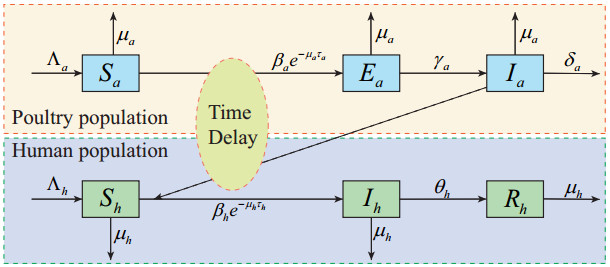









 DownLoad:
DownLoad:




